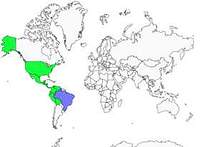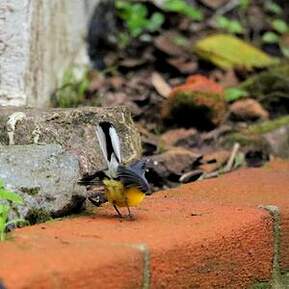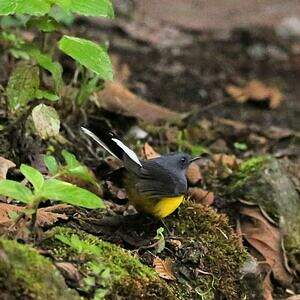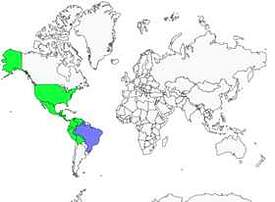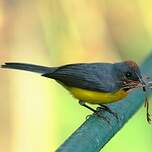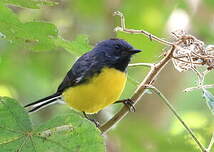Slate-throated Whitestart
Myioborus miniatus - Paruline ardoisée
Identification
The Slate-throated Whitestart has significant variation in its plumage between the historically recognized 12 subspecies, sometimes subject to debate. There is no sexual dimorphism. We find these variations in the color of the underparts and primarily in the extent of the white of the rectrices which have adapted to the bird's environment for insect hunting (see the Behavior paragraph). The adult is characterized by its slate gray upperparts and vivid yellow underparts for all South American populations, vermillion red, orange red or orange yellow for the northernmost populations. The undertail coverts are white whatever the subspecies. The bird's crown shows a median band of red, tawny or chestnut bordered with black, somewhat like our Goldcrests. Its face and throat are jet gray. Its large eyes, its thin beak and its legs are black. Its wings are black, as are its central rectrices. On either side of the tail are three pairs of outer rectrices that are white, in strong contrast above and below. The extent of white of the tail varies according to the subspecies. The juvenile does not have a colored band on its crown. Its head is sooty gray and its upper parts are grayish brown.
Subspecific information 12 subspecies
- Myioborus miniatus miniatus (w and sw Mexico)
- Myioborus miniatus molochinus (e Mexico)
- Myioborus miniatus intermedius (s Mexico and e Guatemala)
- Myioborus miniatus hellmayri (s Guatemala and sw El Salvador)
- Myioborus miniatus connectens (El Salvador and Honduras to nc Nicaragua)
- Myioborus miniatus comptus (w and c Costa Rica)
- Myioborus miniatus aurantiacus (e Costa Rica and w Panama)
- Myioborus miniatus ballux (e Panama to n Ecuador and w Venezuela)
- Myioborus miniatus sanctaemartae (n Colombia)
- Myioborus miniatus pallidiventris (n Venezuela)
- Myioborus miniatus subsimilis (sw Ecuador and nw Peru)
- Myioborus miniatus verticalis (s Ecuador to c Bolivia, se Venezuela, w Guyana and n Brazil)
Foreign names
- Paruline ardoisée,
- Candelita plomiza,
- mariquita-cinza,
- Larvenwaldsänger,
- Meniezanger,
- Codirosso golardesia,
- skiffervitstjärt,
- Skiferhvitstjert,
- horárik bridlicový,
- lesňáček pestrý,
- Rødbuget Hvidstjert,
- huppuviuhkakerttuli,
- bosquerola gola de pissarra,
- pleszówka ciemnogłowa,
- tumšrīkles erickiņš,
- Красно-чёрный горихвостковый певун,
- ベニイタダキアメリカムシクイ,
- 暗喉鸲莺,
- skiffervitstjärt,
- 暗灰喉鴝鶯,
Voice song and call
The song of the Slate-throated Whitestart is a series of notes that could be described as unfinished. The song of Colombian birds has been described as weak, without colour and lacking inspiration: chueet-chueet-chueet-chuee. In the subspecies miniatus, the song is generally faster, with trills, and described as a varied series, often changing in height in the course of the route, the second part accelerating and usually ending abruptly or with a gliding note upwards: s-wee s-wee s-wee s-wee s-chi s-chi s-chi, or chi-chi-chi-chi chiree-chiree-chiree-chiree.
Habitat
The Slate-throated Whitestart is a permanent resident species who is not migratory, living year round in the same habitat.
Behaviour character trait
The Slate-throated Whitestart lives in pairs and feeds in the lower to mid-level vegetation, sometimes on the ground when it follows an army ant swarm carrying insects. The species is very territorial but during its food foraging it is very common to see it among the typical flocks of birds of the South American continent. It can be aggressive towards other species of parulines during these flocks, an attitude that is completely absent with other passerines. To avoid these situations, the species prefer to avoid each other. In Ecuador, for example, there is an area where the distribution of the Slate-throated Whitestart and that of the White-winged Paruline overlap.
Both species prefer to favor slightly different micro habitats. The species is known for its display during its food search, jumping and fluttering through the foliage, on trunks or along branches. Indeed, it adopts a very typical attitude known as flush-pursuit. Each continent has its own followers, such as the Rhipiduridae in Australasia. When hunting insects, it is to drop the slightly spread wings and to pivot from side to side with the tail erect and extended like a fan. As for the Slate-throated Whitestart, this posture highlights the black and white color contrasts of the rectrices, the goal being to scare the insects which are then attacked and captured in flight giving rise to complex and acrobatic pursuits. To do this, the Slate-throated Whitestart presents many morphological adaptations such as a long tail, short and wide wings, large eyes and vibrissae at the base of the beak. Its other usual movements are simple: to jerk, climb, walk.Flight
Dietfeeding habits
Reproduction nesting
The male of the Slate-throated Whitestart is faithful to the nesting site for its entire life. The female, on the other hand, can make small movements due to the death of its partner. Both sexes are very territorial and aggressive to any potential intruders. The couple is usually monogamous and lives together all year round. The breeding season stretches from late March to late June for the northern and central part of its range. In the more equatorial zone it takes place from late December to July in Colombia and from May to December in Ecuador. The couple establishes its nest on the ground on the slopes of undisturbed mountain forests or on the banks along roads and trails if it lives in areas of human activity.
Occasional nests can be established in the epiphytes of fallen trunks on the ground. The female is responsible for building the nest, which is a dome shape well hidden in vegetation. The size of the clutch will vary depending on the region, between 1 and 4 eggs. The female lays during the first hours of dawn over several days, she incubates only at the end of the clutch and only for 14 to 18 days, always depending on the region. Occasionally the male will come to feed the nest. The couple only makes one nesting per year. The male and female feed the chicks together. They will do this at least until the fortieth day of the young even if they are capable of feeding themselves at 30 days. Once autonomous, the female's dispersal is wider. A female can travel up to 935 meters away from its birth site, compared to 485 meters for males. The species is potentially parasitized by lice and other blood parasites weakening the clutches and even leading to the death of the chicks.The success rate of nests and survival until the first year after take-off remain very low.Geographic range
The Slate-throated Whitestart (Myioborus) is the most widespread species of its genus. Its range extends from the montane forests of northern Mexico to most of Central America, with the exception of the Yucatan Peninsula, Campeche state, Quintana Roo province and Tabasco. It is absent from Belize and very scarce in Nicaragua. It can also be found to the north of South America, and to the south through the Andes, all the way to the center of Bolivia. Occasional wanderers from northern Mexico are occasionally observed in the southwestern United States, and a small, breeding, disjunct and apparently migratory population has recently established itself in the Sierra del Carmen, in northeastern Mexico. All this data suggests that an expansion northwards of the species might be possible.
Threats - protection
IUCN conservation status
concern
in the Wild
threatened
evaluated
Without quantitative data or trends for the future, it is believed that the populations of the Slate-throated Whitestart are in decline. The species appears to be adapting to human disturbances in some places. In the future, more in-depth studies are envisaged on certain geographically little-known populations, in particular on reproduction, life cycle and analysis of the geographical variations of the song of the subspecies. The impact of human activities must also be better studied. It is also important to study the molt of this species since we know that the feathers of the tail play a primary role in the hunt for flying insects. The Slate-throated Whitestart is nevertheless classified as of minor concern due to its extremely extended distribution area.
Sources of information
- IOC World Bird List (v14.2), Gill, F and D Donsker (Eds). 2024-04-18.
- Birds of Ecuador, Juan Freile and Robin Restall
- Birds of the World, The Cornell Lab of Ornithology
- eBird, Cornell Lab of Ornithology et National Audubon Society
Other sources of interest
 Specification sheet created on
17/07/2023 by Nathalie Santa Maria
Specification sheet created on
17/07/2023 by Nathalie Santa MariaTranslation by AI Oiseaux.net
© 1996-2025 Oiseaux.net
- Accipitriformes
- Aegotheliformes
- Anseriformes
- Apodiformes
- Apterygiformes
- Bucerotiformes
- Caprimulgiformes
- Cariamiformes
- Casuariiformes
- Charadriiformes
- Ciconiiformes
- Coliiformes
- Columbiformes
- Coraciiformes
- Cuculiformes
- Eurypygiformes
- Falconiformes
- Galliformes
- Gaviiformes
- Gruiformes
- Leptosomiformes
- Mesitornithiformes
- Musophagiformes
- Nyctibiiformes
- Opisthocomiformes
- Otidiformes
- Passeriformes
- Pelecaniformes
- Phaethontiformes
- Phoenicopteriformes
- Piciformes
- Podargiformes
- Podicipediformes
- Procellariiformes
- Psittaciformes
- Pterocliformes
- Rheiformes
- Sphenisciformes
- Steatornithiformes
- Strigiformes
- Struthioniformes
- Suliformes
- Tinamiformes
- Trogoniformes


